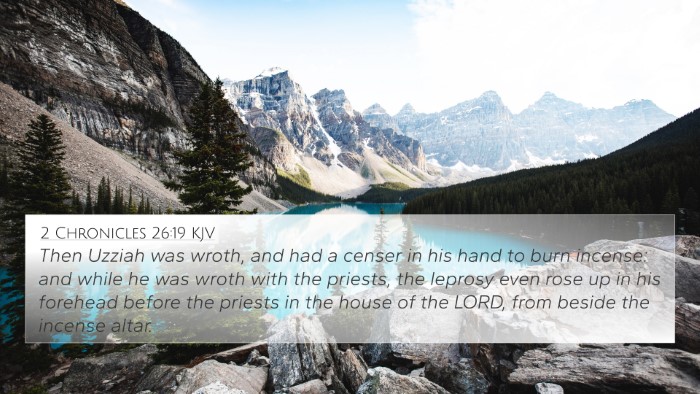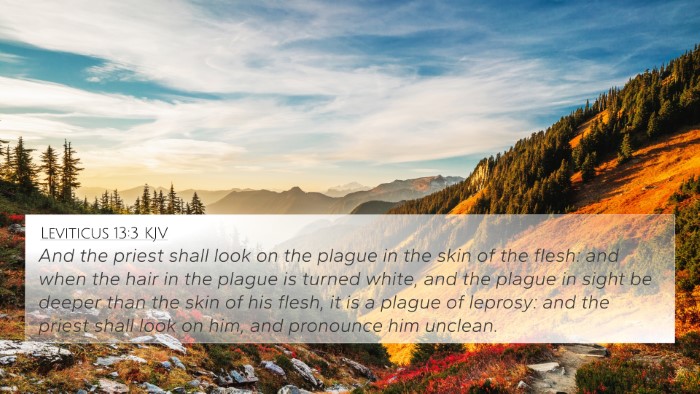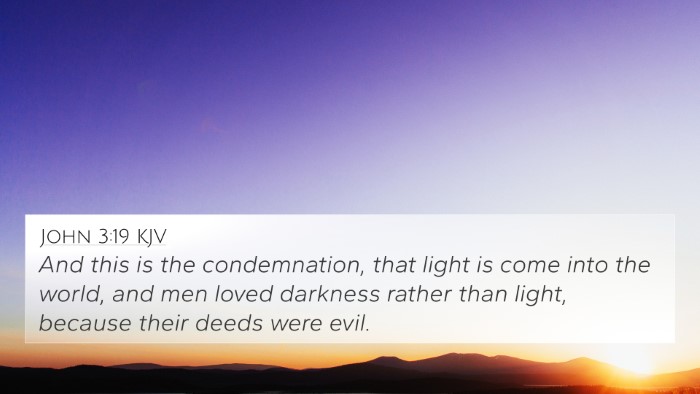Understanding Leviticus 13:10
Leviticus 13:10 states: "And the priest shall see him: and, behold, if the rising be white, and it have turned the hair white, and there be quick raw flesh in the rising." This verse is part of the Mosaic Law regarding the diagnosis of leprosy and other skin diseases, sanctioned by priests. Understanding this verse requires careful exploration of its implications both in its immediate context and its broader theological narrative.
Context and Meaning
This verse occurs within a larger chapter that details the process of identifying and managing skin diseases among the Israelites. The priest's role is central; he is responsible for determining whether a condition is leprous, which underscores the importance of religious authority in matters of health and community purity.
The Role of the Priest
- Authority in Health Matters: The priest acts as a mediator between God and the people, ensuring that they adhere to divine guidelines for maintaining purity.
- Symbol of Spiritual Oversight: In this context, health issues are also seen as spiritual ailments, suggesting a deeper connection between physical and spiritual wellness.
Descriptive Indicators
The specific symptoms described—white rising, white hair, and raw flesh—serve as definitive indicators of a serious condition. Such detail emphasizes the necessity for thorough examination before concluding the individual's status.
Cross-References and Connections
Understanding Leviticus 13:10 can benefit from connecting it with other relevant scriptures. Below are several cross-references that shed light on themes of health, purity, and divine law:
- Leviticus 14:1-32: Instructions for the cleansing of lepers.
- Numbers 5:2: Command regarding the expulsion of individuals with leprosy from the camp.
- Matthew 8:2-3: Jesus healing a leper, proclaiming the fulfillment of the law.
- Mark 1:40-44: Another account of Jesus cleansing a leper, emphasizing compassion and authority.
- Revelation 21:27: The concept of purity in the New Heaven and New Earth.
- Isaiah 53:4: Prophetic indication of Christ bearing our infirmities.
- 1 Corinthians 5:6-7: A metaphorical application of leaven and purity among believers.
Thematic Connections
This verse also reveals themes such as:
- Spiritual Defilement: Leprosy often symbolizes sin and separation from God.
- Divine Judgment: The Israelite understanding of physical ailments often linked to spiritual condition.
- Community Standards: The communal aspect of health and purity underpins the law, showing that personal issues often affect the broader community.
Practices of Cross-Referencing
For those exploring connections between biblical texts, especially concerning skin diseases and purity, various tools for Bible cross-referencing can be invaluable:
- Utilizing a Bible concordance helps locate verses thematically.
- Employing a cross-reference Bible study enables deeper thematic exploration.
- Engaging in a Bible reference resource can facilitate understanding of complex laws.
Conclusion
Leviticus 13:10 serves as a crucial text within the holistic biblical narrative concerning purity and healing. Its analysis alongside related verses provides insights into how the Old Testament laws echo throughout New Testament teachings, particularly in the life and ministry of Jesus Christ, demonstrating continuity in God's concern for both physical and spiritual wellness.












